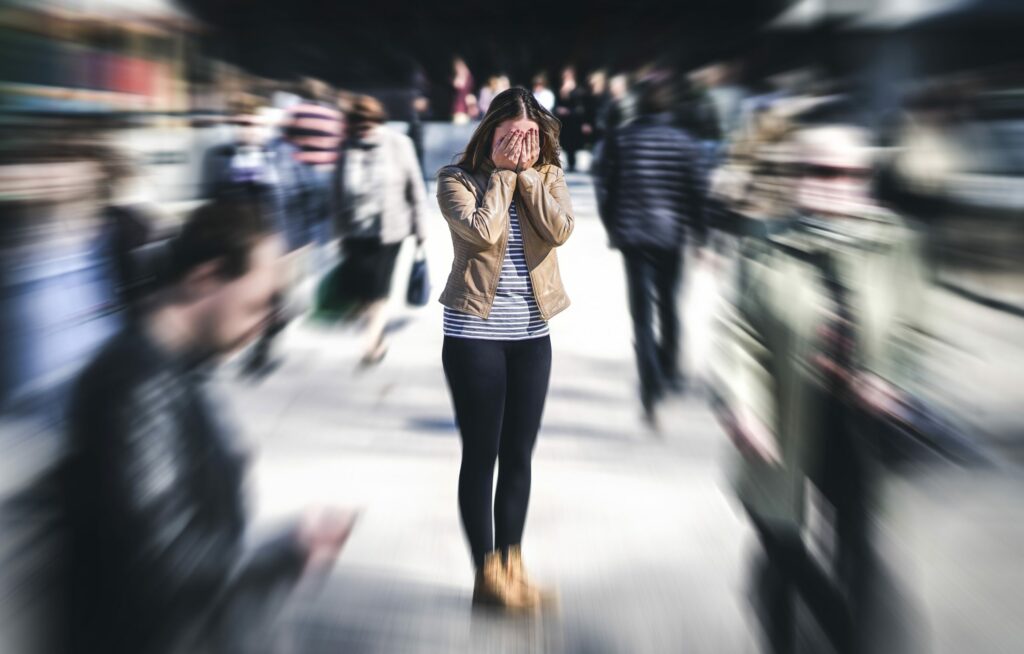
There are many reasons why people feel anxiety. Depending on the circumstances, anxiety can arise for positive and negative reasons. Anxiety is a natural and sometimes healthy emotion. Happy events can produce anxiety. For example, moving, starting a new job, getting married, having a baby, and buying a house. When people experience anxiety for “happy” reasons, the worry and apprehension that occur typically resolve with the event or soon after once the brain realizes there is no longer anything to be anxious about.
Unfortunately, not all anxiety arises from positive sources. Negative people, situations, and events can also lead to anxiety. This type of anxiety often produces feelings of terror, intense fear, and panic. If you are one of the many people who struggle with an anxiety disorder, you experience persistent and severe feelings of worry and fear. Although some of these emotions stem from specific situations or events, other times, anxiety is related to ordinary, everyday occurrences.
More often than not, the symptoms you or a loved one experiences when struggling with anxiety are impossible to control and out of proportion to the actual danger that caused worry. Unfortunately, these symptoms can cause you to actively avoid places, events, situations, and even people that may lead to anxious feelings. There are many things people do to try and manage anxiety. Some may try to reduce the weight of their symptoms through self-medication. If they experience worry or fear, or even panic, they reach for alcohol or drugs to reduce the effects of anxious symptoms. Unfortunately, using drugs or alcohol to manage anxiety symptoms leads to a range of additional problems, including the physical and psychological impacts of other mental health challenges or a co-occurring substance use disorder.
What is Anxiety?
Many people look at anxiety as the simple fear or worry that arises from various events that occur in one’s life. But an anxiety disorder is more than that. When you have an anxiety disorder, your symptoms are persistent and do not go away without support and therapeutic intervention at a treatment center like The Meadowglade. Most people diagnosed with an anxiety disorder develop symptoms early on (sometimes in early childhood) that persist into adulthood.
There are several types of anxiety disorders, including social anxiety disorders, phobias, generalized anxiety disorders, and separation anxiety. It is possible to have one or multiple anxiety disorders. Regardless of the type of anxiety you struggle with, it is essential to seek professional help at a treatment center like The Meadowglade, where you can learn how to overcome anxiety and leave anxiety treatment with the tools and skills necessary to safely and effectively cope with triggers in the future.
According to the National Alliance on Mental Illness (NAMI), anxiety disorders are the most common illness in the United States. Data shows that as many as 19% of the population (approximately 40 million adults) in the United States over age eighteen struggle with anxiety. Like and many other mental health conditions, anxiety disorders are treatable, yet few of those who could benefit from treatment ever seek or receive the help they need. The Anxiety and Depression Association of America (AADA) estimates less than 37% of people with anxiety disorder get treatment.
Symptoms of Anxiety
Anxiety is more than a singular diagnosis such as diabetes or heart disease. An anxiety disorder diagnosis is a diagnosis that encompasses a group of connected or related conditions. Each of these conditions has various shared symptoms and symptoms unique to the disease, not necessarily seen in any others.
The most common symptom experienced across all anxiety disorders is an excessive and persistent fear of things that are (to anyone else) unthreatening. Someone with anxiety experience a range of physical and psychological (emotional) symptoms. Common emotional symptoms may include restlessness, irritability, feelings of dread, feeling “jumpy” or tense, and being hypervigilant (always on the lookout for danger. Physical symptoms of anxiety may include shortness of breath, racing heart rate, sweating, fatigue, insomnia, headache, and stomach disturbances.
Types of Anxiety
The Diagnostic and Statistical Manual for Mental Disorders lists diagnostic criteria used by mental health providers to diagnose anxiety disorders. While there are several possible diagnoses, five specific types are more common among the population than others.
Generalized Anxiety Disorder
Someone with a generalized anxiety disorder experiences chronic anxiety symptoms. They struggle with feelings of heightened worry and tension regardless of whether there is a reason to feel such emotions.
Obsessive-Compulsive Disorder (OCD)
Someone with obsessive-compulsive disorder experiences recurrent and unwanted thoughts, also referred to as obsessions coupled with repetitive behaviors or compulsions. Repetitive behaviors may include tasks such as checking, cleaning, counting, or even hand washing. Compulsions are performed in the hopes of reducing the intensity and severity or even the presence of obsessions. Compulsions are also referred to as rituals, and unfortunately, despite their interference with one’s day-to-day activity, they only provide temporary relief. However, failure to perform them often leads to excessive anxiety.
Panic Disorder
Panic disorders are a type of anxiety disorder characterized by repeated and often unexpected episodes of overwhelming fear. Fear is accompanied by various physical challenges, including racing heart, difficulty breathing, stomach problems, and others.
Post-Traumatic Stress Disorder (PTSD)
Post-traumatic stress disorder often occurs after you experience an event that leads to harm or the threat of harm. Examples include natural disasters, assault, violence, and accidents. Soldiers who serve on active combat deployments experience high rates of post-traumatic stress disorder.
Social Phobias
Social phobias are also referred to as social anxiety disorders. Someone with a social phobia experiences uncontrollable anxiety and feelings of self-consciousness during everyday social situations.
5 Tips for Safely Managing Your Anxiety
Many people who struggle with anxiety frequently turn to substances such as drugs and alcohol to help manage their symptoms. Unfortunately, this is not a beneficial, healthy, or effective way to manage anxiety long-term. Although drugs and alcohol do provide a temporary sense of relief from fear and worry brought about by anxiety, the comfort is often short-lived. Once the effects of the substance wear off (usually in a matter of hours), the anxiety symptoms return. By seeking help at a treatment center like The Meadowglade, you can learn and practice safer and more effective ways to manage anxiety. As part of therapy, your provider will work with you to develop coping strategies you can utilize when faced with triggers in the future.
In addition to seeking help to overcome anxiety, below are a few tools you can use in your home environment to manage your symptoms.
Eat a balanced diet and get enough sleep
Although both are easier said than done for many people, diet and rest are vital factors in maintaining your physical and psychological health. When you are fatigued and your body is trying to carry out essential functions using inadequate nutrients, it is a recipe for failure. When you are feeling down and off the pace, it makes it easier for stress and anxiety to take over. Be sure to eat a balanced diet and get adequate sleep by maintaining (whenever possible) a regular sleep schedule.
Learn about and practice mindfulness
Mindfulness techniques such as yoga and meditation have been used for centuries as a way to improve relaxation and focus. Mindfulness techniques are an excellent way to reduce anxiety and stress levels while focusing your mind on the now. Additionally, some forms of mindfulness, such as yoga, are excellent, low-impact ways to improve flexibility and incorporate exercise into your day.
Avoid stressors
Another anxiety reduction technique is to avoid the things that cause anxiety. Like sleeping and eating well, this may also be easier said than done. But it is important to remember that if you are feeling anxious, participating in a stressful conversation or interacting with a stressful person will only worsen your symptoms. Try to save these interactions for a time when your emotions are in a better place.
Be ok with not being ok
Anticipating stress or a stressful event may also increase your anxiety levels. Remember, while it is ok to feel concerned about the unknown, it is important to manage concern about future situations in a healthy way. Instead of allowing fear about what you cannot change or control lead to fear and stress, consider the source of your worry and the potential positives that could come from the situation.
Try a new hobby (or get back to an old one)
Self-care is a great excuse to return to hobbies or pastimes you once enjoyed. It is also a great reason to try something new that you have always wanted to try. Finding or returning to a hobby allows you time to focus your attention on something positive, helping reduce stress and anxiety.
If anxiety symptoms begin to impact your day-to-day life or limit your ability to participate in work or family obligations, seeking help to address your anxiety at a treatment center like The Meadowglade can help you heal and begin the journey towards a future without debilitating anxiety. Anxiety disorders can be a challenge for anyone to manage without help and support. Here at The Meadowglade, our team of caring and supportive treatment providers will work with you to help you understand the roots of your anxiety and how you can effectively put struggles with it in the past.
Recommended: Anxiety Disorder in the Workplace: How to Recognize and Combat It
If you are ready to seek help to overcome anxiety, contact a member of our admissions team at The Meadowglade today to learn more about how therapy for anxiety can help. Our staff is here to provide the support and guidance you need to get started on your journey to freedom from anxiety and the challenges so often experienced when trying to navigate its complex and challenging symptoms.
